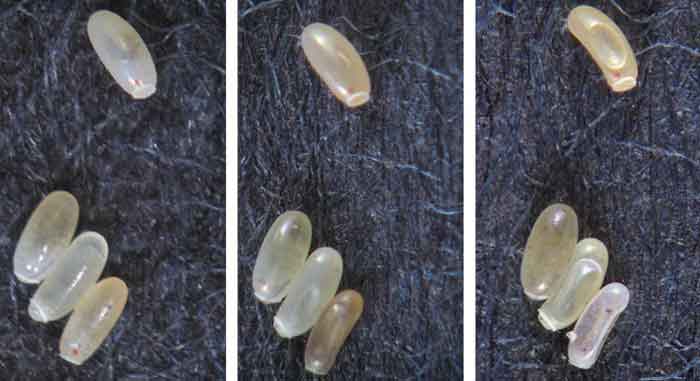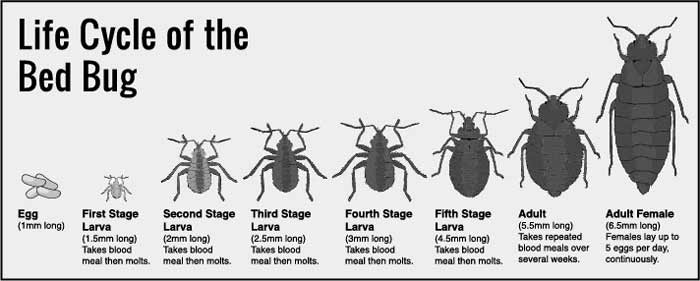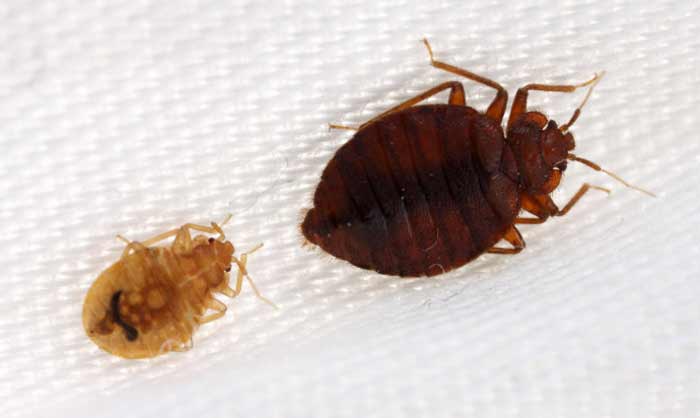Like many other insects, the life cycle of bed bugs starts after mating of male and female. Thereafter, laying and hatching of eggs follows. Read on for details on early stages which involve baby bed bugs and their characteristics all through to the late stages of growth (adulthood)
Table of Contents
Early Stages of the Life Cycle
Eggs
The eggs are visible to the human eye although it can be hard to see them some times. You might need to have a magnifying lens to have the eggs become more visible.
The eggs look like pieces of rice. They can be compared to a large grain of salt. They are tiny and light in color that ranges from translucent to a milky white color.
The eggs have a sticky film that lines them and this makes them have a shiny appearance. The film enables them to be glued to the surface till they hatch.
In normal occasions, the eggs can take about 10 days to completely hatch. When they hatch, they look clearer and similar to a deflated balloon. The eggs lose their shine once they are hatched and instead have a dried appearance.
Early stages of bed bug growth
The early stage of growth is called the nymph. They are also called young bed bugs and they have to pass through five stages of molting before the maturity stage. They are similar to adults but rather very small ad not yet sexually mature.
The nymphs are yellow-white in color when young but turn reddish-brown as they grow older. Each nymph requires a blood meal so as to molt into mature nymphs and bed bugs. It takes about five weeks for nymphs to molt and become an adult bed bug.
The molt process of the nymphs is scientifically called ecdysis which is a term that is commonly used to describe the way invertebrates shed their exoskeleton so as to create room for regeneration of new tissues.
Late stages
Immediately after the nymph stage, the adult bed bugs are made. This is the last of the stages of bed bug life cycle. It occurs under the favorable conditions which can last for about 6 to 12 months. The adult bed bugs will spend most of their life hiding and digesting food as they mate and lay eggs.
Life cycle of bed bugs timeline-how long is it?
The life cycle of bed bugs takes about 40 days when they are well fed. It is possible that the cycle may take longer if the food is limited.
The life cycle begins with the egg and then carries on with the other stages. Bed bugs require blood meal to facilitate their transitions from one stage to another.
They prefer human blood mostly although they can also take blood from other animals and pets. The bugs can feed as many times as 9 times in a day before molting to the next stage.
They will attack during the night although during the day is also feeding time especially if they have gone without food for a long period of time.
In the feeding stage, the young bed bugs, nymph feed at least once before they molt. They could feed more than once in a day. The nymphs can then survive without a blood meal for days or several months.
The adult nymphs and adult bed bugs are able to survive longer than a month without a blood meal provided the conditions are favorable.
Baby Bed Bugs, what they look like Pictures & Growth Stages
what do baby bed bugs look like?
They are newly hatched eggs of bed bugs. Once they hatch, the first thing they do is search for a blood meal. They always go through five stages of development called instars, where the first instar is the newborn while the 5th instar is the bed bug teen.
These bugs appear light in color and almost clear. Their size and color are similar to the color of a sesame seed and can grow to about 5 mm when they become adults. The moment they have a blood meal, their color changes to look like purple balloons.[1]
Size-how small are they
Bed bugs are entirely very small to the tune of 0.1 inches long and they appear white or half transparent that is similar to a grain of an uncooked white rice.
Nymph growth Stages
The nymph stage of bed bugs goes through five stages of molt to get to the adult stage. These stages are called instars. After the eggs, the nymphs grow into first instar nymph.
This stage is always hard to find unless the nymph has really had a blood meal. The baby bed bug is about 1.5 mm long and once it has had a blood meal, it molts to the next stage.
- Thereafter, there is the second instar nymph. In this stage, the bed bug is about 2 mm long and once it takes a blood meal, it is able to molt to the third instar.
- In the third instar nymph, the nymph is about 2.5 mm long and it is able to feed on a blood meal then molt to the next instar.
- During the fourth instar, the nymph is about 3 mm long and once it takes an adequate amount of a blood meal, it transits to the next instar.
- The final and the highest is the fifth instar. In this, the nymph is ready to transform into an adult bed bug. It is about 4.5 mm long. Once it feeds properly on a blood meal, the instar grows into an adult bed bug that is about 5.5 mm long.
How long can baby bed bugs live without feeding
The age of the bed bug dictates how long it can stay without food. Because of the numerous activities of continuous molting of the nymph, the baby bed bugs, the nymph need continuous feeding so as to become adults. It could take at least a few weeks without feeding for the nymphs to succumb.
How many babies do bed bugs have?
On average, a healthy female bed bug will lay between 200 to 250 eggs during her lifetime. That means a bed bug can have over 200 babies under favorable conditions.
The bed bugs can lay about 2-5 eggs on a daily basis.
The number of eggs depends on interesting factors such as mating frequency. Female bed bugs who mate more lay lesser eggs while those who mate less lay more eggs.
Mating causes scarring therefore the females will tend to avoid it. They will travel to stay away from more scarring.
It is estimated that a single pregnant female can result to an infestation of over 5,000 bed bugs within six months.
It takes an incubation period of about 18 days before the eggs hatch to young nymphs. This period depends on factors such as temperature.
A lowered temperature on the other hand is likely to lower this process making the hatchery period longer. When you increase the ambient temperatures, the hatching process is hastened.
Precisely, if the temperature is between 70 and 80 degrees F, it would take about 5 weeks to move from the eggs all through the juvenile stage to become adult bed bugs. There can be about 3 generations of bed bugs being born in a year.
Adult Bed Bugs-Appearance, size & Pictures
The adult stage of the bed bug growth is the 7th and last stage. They have specific features that are quite different from the nymphs.
What does it look like?
The adult bed bugs appear brown in color even though their bodies tend to become redder as they feed. They have small bodies that are flat and oval in shape.
They are wingless and instead have some vestiges that are termed as wing pads. These pads do not develop into fully functional wings.
Size
When fully grown, it can be as long as 5.5 mm. The diameter and length are likely to increase as the bug feeds. This indicates that after a great blood feast, the bed bug can increase to as long as 6 mm or even more.
Notable features that differentiate them from baby bed bugs
The color of the adult bed bugs makes them different from the baby bed bugs. The other thing is that you can see them using your naked eye unlike the baby bed bugs which are hard to see.
The adults are also found in the cracks and crevices in which they hide most often.
Female adult bed bug vs male
Being able to mark the difference between the male and female bed bugs is the key tool to knowing how serious an infestation by bed bugs can be. It also gives you an opportunity to monitor how fast a colony of bed bugs can grow under the right conditions.
Are there any differences?
There are very crucial and notable differences between the male and female bed bugs in as much as there are quite a number of similarities. They differ in terms of size, color, behavior and even symmetry. All these enable you to distinguish them.
- The first and perhaps the easiest thing you could look at is the reproduction. If you are keen enough, you could look at the bed bugs reproducing. This is the easiest and most obvious point of differentiation. The males will mostly rest on the swollen abdomen of the female bed bug.
- Female bed bugs are also distinct from the males because they have more symmetrical bodies and more rounded rear ends. The males have smaller, sharper and in other occasions asymmetrical ends.
- The first set of legs also give the differences. The legs are found on the head or the neck but below the antennae. The first legs of the female bugs tend to protrude higher on their bodies and they thus emerge from the upper region of the neck and even the head. In males, the first set of legs are lower on their bodies and this could be attributed to their smaller size[2]
Further Reading
- Bugs that look like Bed Bugs-Beetles & Others that Resemble or Mistaken
- Bed Bug Bombs-Do Foggers work? Effectiveness & Reviews
- Bed Bug Repellents -Natural Homemade, Creams, Electronic & Reviews
- How do Bed Bugs Spread? Are they Contagious? How Fast/Easily from Person, Room or House?
- Best Bed Bug Sprays-DIY Homemade, Natural, Brand Reviews
- Flea Bites vs Bed Bug Bites + Differences & Pictures
- How to Prevent Bed Bugs-Bites while Sleeping at Home, School, Hotel & Travelling
- How to get rid of Bed Bugs on Clothes-Can they Live, Bite through or Travel on Laundry
- Fumigation for Bed Bugs-Cost & Preparation
- How to get Bed Bugs out of Carpet with Cleaner & Powder
- How Long do Bed Bugs Live Without Food, Host, Air, in Cold & After Spraying
- Bed Bug Rash on Skin, Pictures, Treatment, Allergy & Symptoms
- Where do Bed Bugs Hide and how to Find them
- Mosquito Bites vs Bed Bug Bites-What’ are the differences
- Identifying Bed Bug Eggs- How they look like, Images & destruction
- How do you know if you have Bed Bugs-Symptoms & Signs
- Bed Bug vs Spider Bites- Differences with Pictures
- Bed Bug Sniffing Dogs-How they smell, Sense, Roscoe, Breeds & Cost
- What are Bed Bugs? Names in other Languages
- Where do Bed Bugs come from? Causes, how you get them & Start
- How to Kill/Get Rid of Bed Bugs Fast Yourself Naturally for Good
- Bed Bugs in Hair Symptoms, Pictures & Get rid
- Types of Bed Bugs
- Bed Bug Poop/Droppings-How it looks like, Pictures +Identification
- Bed Bug Shells, Cast Skin & Exoskeleton
- Can you See Bed Bugs with the Naked eye? Pictures, Size, Color & Anatomy
- Dust Mite vs Bed Bug Bites
- Bed Bug life cycle-Eggs, Baby(Nymph) to Adult Stages & Pictures
- How to Detect Bed Bugs-Detectors, Light & Verifi Reviews
- How to know if Bed Bugs are gone after Treatment & what to do
- Will Bleach Kill Bed Bugs-How does it work?
- Best Bed Bugs Traps- DIY Homemade, Co2, Yeast + Reviews
- How to Deal with Bed Bugs in your Car
- Bed Bugs in Couch-Covers, Signs & How to Get rid
- How to Kill Bed Bugs with Steam: Best Steamers & Guide + Tips
- Does Alcohol Kill Bed Bugs? Rubbing, Isopropyl & Percentage
- How Long do Bed Bug Bites Last, Take to Appear, Go Away & Heal
- Natural Predator of Bed Bugs-What Insects/Bugs eat Bed Bugs?
- Can Bed Bugs Live in TVs & Other Electronics? How to get them out
- Do Bed Bug Bites Itch or Hurt?
- Bed Bug Interceptor-How it works, DIY & Reviews
- What do Bed Bug Bites look like? Pictures & Identification Steps
- What Attracts Bed Bugs & things they Hate /Dislike Most
- Can Bed Bugs make you Sick? How are they Dangerous?
- Can Bed Bugs Fly-Do they have Wings-How Far can they Travel
- Diatomaceous Earth for Bed Bugs-How to Use & Best Reviews
- DIY Bed Bug Heat Treatment: Success Rate,Temperature Chart, Preparation & Reviews
- Does Vinegar Kill Bed Bugs? Can it be Used for Bites?
- How to Get Rid of Bed Bugs on Mattress- Best Covers, Protectors & Encasement Reviews
- Can Bed Bugs live on or Bite Dogs & Cats (Pets)?
Sources
[1] http://www.bedbug-answers.com/bedbug-life-cycle.html
[2] https://sciencing.com/tell-between-male-female-bedbugs-8648064.html


